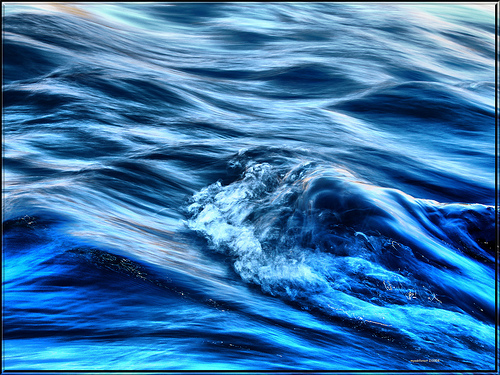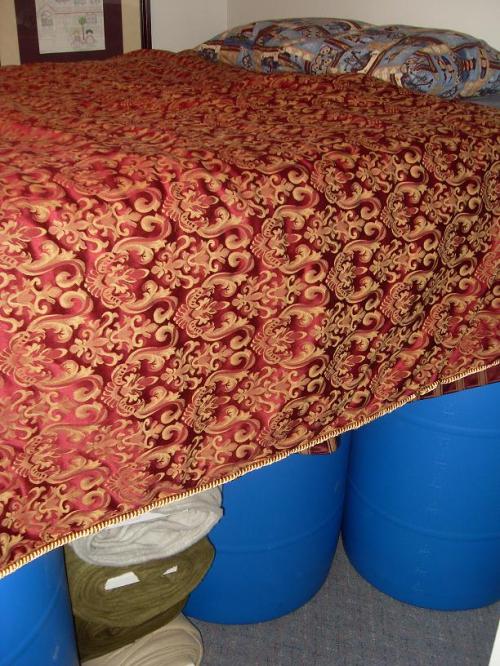Recently I’ve been inundated with requests from readers to know how I’ve personally prepared for the future. These requests have come about as a result of my blog post of Gerald Celente’s economic forecasts (see link here). In fact, I’ve even create an entirely new blog called Preparedness Pro, devoted exclusively to emergency preparedness in the categories of food (including cooking), water, first aid, self-defense, finances, and emotional preparedness. Be sure to add this one to your blogroll (http://preparednesspro.wordpress.com) and check back often!
What makes me a pro? I’ve been practicing personal preparedness doggedly for over 9 years. Our house has 3 full rooms of necessary emergency supplies. Usually, instead of going to the store, I just go downstairs to our food storage room, grab what I need, and replenish about every 6 months or so. It will be up to you to decide whether or not what I share with you has merit.
 First Things First—WATER!
First Things First—WATER!
If you have not started preparing for an emergency, do not start with food. Start with WATER! If you’ve already started a sufficient emergency supply food storage, you are probably like the majority of individuals and have put off storing water. “Where am I going to store those ugly barrels?” you ask? Believe me, that’s the last thing you’re going to care about when you need water.
How much water should I store?
You can go without food a heck of a lot longer than you can water. I know this may sound a bit overwhelming, but you really need to store enough water to provide you and your family with 1 gallon per day—minimum—for at least 3 months. Allow me to restate this. 1 gallon per person is MINIMUM. That’s a lot. But you don’t need to go back too far in history to realize that such a need could exist. Think of the hurricanes our nation has had in recent history. Is your area ripe for an earthquake? What if some moron crashes their chemical truck into your water supply?
Keep in mind that that one gallon of water is not just for drinking. It’s for hygiene, (and don’t even think that you’ll avoid bathing all together…this will foster serious illnesses, among other things) cooking, toilet use, laundry, and cleaning.
How do I store my water?
 Store your water in NEW barrels. Please don’t store water you intend to use for drinking and cooking in barrels that have been used for something else. You will suffer, indeed. (It’s fine to use those kinds of barrels for water you will use exclusively for cleaning, etc.)
Store your water in NEW barrels. Please don’t store water you intend to use for drinking and cooking in barrels that have been used for something else. You will suffer, indeed. (It’s fine to use those kinds of barrels for water you will use exclusively for cleaning, etc.)
Please, please, please do not store your water in empty milk or soda pop bottles. They deteriorate. (Although is you have to choose one of them, pick the soda pop bottles instead. They last a bit longer)
Should I store purified water?
Don’t treat your water before storing it. Chance are very good that it’s already been sufficiently treated by your municipality. Besides, I would recommend treating your water prior to using it for drinking or cooking anyway. To do this you want to use 8 drops of pure chlorine per gallon of water.
You can fill your water barrels through the garden hose. As long as you let the water run through the hose a bit and there aren’t any bugs sitting in it, you’re fine. Surely you drank out of a hose when you were little and you’re no worse for wear, right? If you’re a purist, you can purchase a marine hose that is lined with an anti-bacterial coating. Those are readily available at your local hardware store.
Keep in mind that the water in your water heater, water bed, and toilet tanks is usable as well.
Iodine tablets, colloidal silver, and quality camping water filters are also a good preparedness step in the event you’re required to use water from sources you’re not familiar with.
One of the things that I stock up on as well are the little Xooma water sachets. These small, tea bag like sachets contain minerals and such that can bring your water to a good non-alkaline levels and infuse minerals in them. I personally believe that doing so helps for better hydration to the body. So I keep stocked up on these for an emergency as well. You can check them out at http://www.xoomaworldwide.com/WaterDiva/
How often do I replace the water?
We empty and refill our water barrels every two years. You don’t need to do it that often, but we’re a bit fanatical about things. You’re fine to go out 5 years prior to refilling them as long as it’s good water to begin with. You will want to aerate your water though prior to drinking it. Doing this is as simple as pouring it a few times from one container to another, such as a couple of pitchers.
Where am I supposed to store all this water?
 If you’re in a small apartment, you will be pleasantly surprised how easily you can disguise a water barrel as an end table with a small round piece of plywood and a classy decorative tablecloth. We are fortunate enough to have enough space in our basement and have several of them lined up and then have plywood stacked on top of them to begin shelving for our food storage.
If you’re in a small apartment, you will be pleasantly surprised how easily you can disguise a water barrel as an end table with a small round piece of plywood and a classy decorative tablecloth. We are fortunate enough to have enough space in our basement and have several of them lined up and then have plywood stacked on top of them to begin shelving for our food storage.
Note to wives: If your overzealous husband convinces you to store “an extra” eight 50-gallon barrels under one of the guest beds, you may want to think twice. It’s a family joke now when folks come to stay with us and sleep in the “water bed.”
Don’t buy into the myth that you can’t store your water barrels on cement. Clarification is that you should not store your water on cement that gets heated by the sun. So if you’re storing it outside, the sun will heat the cement, which will then heat your water. This makes water taste nasty. If you’re storing them outside, place the barrels on top of 2 x 4s.
You can store your water barrels outside in freezing weather, but you run the risk of them freezing and cracking. At the very least, you should not fill them up to maximum capacity to allow for the freezing expansion.
Conserving Water
Consider ways to conserve water in an emergency as well. Storing paper goods such as paper plates and cups will eliminate cleaning, and learning to cook with a pressure cooker which uses a minimum amount of water for cooking is also a good idea. (more on pressure cooking in a future blog.)
| Copyright 2009 Kellene Bishop. All rights reserved. |
| You are welcome to repost this information so long as it is credited to Kellene Bishop. |
